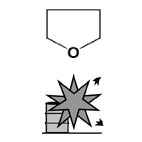| Case Name |
Explosion and fire of tetrahydrofuran during air-pressure transfer to a tank from a drum can |
| Pictograph |

|
| Date |
October 24, 1995 |
| Place |
Ikuno, Hyogo, Japan |
| Location |
Chemical factory |
| Overview |
An explosion and a fire of an organic chemical occurred at a chemical factory. By pressurizing a drum can with air, tetrahydrofuran was transferred to a tank. The drum can exploded and a fire occurred. The method was imperfect and unsuitable, although static electricity preventive measures were taken. Therefore, a combustible gas-air mixture in the drum can is considered to have been ignited by static electricity sparks generated by a liquid flow, followed by an explosion. |
| Incident |
An organic chemical fire occurred at a chemical factory. By pressurizing a drum can with air, tetrahydrofuran was transferred to a raw material intermediate tank. An explosion occurred and the drum can was blown apart. Tetrahydrofuran splashed indoors and a fire occurred. The cause is considered that vapor in the drum ignited and exploded due to static electricity sparks produced during work. |
| Processing |
Manufacture |
| Individual Process |
Transfer |
| Process Flow |
Fig2.Unit process flow
|
| Substance |
Tetrahydrofuran, Fig3 |
| Type of Accident |
Explosion, fire |
| Sequence |
09:45 on October 24th, 1995. Drum cans of tetrahydrofuran were carried into the adjustment room of the factory. Transfer and pressurization pipes were connected to drums.
Earth wire of the flexible part of transfer piping was connected to air piping for pressurization.
10:05. An explosion occurred during transferring the 2nd drum can. The bottom plate of the can fell out and the main body of the can blew into the air. Tetrahydrofuran dispersed, covering an operator and inside of the room, and a fire occurred. A coworker extinguished the fire.
10:09. The fire department was notified about the fire. Four fire engines and nine fire fighters turned out. To prevent a secondary accident, hazardous materials indoors were moved.
10:25. The fire was confirmed to have been extinguished. |
| Cause |
Earth wire was attached to the flexible portion of transfer piping. Operators wore static electricity preventing shoes. However, the earth wire was connected to air piping for pressurization. Moreover, the piping nozzle for transfer inserted into the drum was made of polyethylene, which is non-conductive. For this reason, static electricity was charged by the flow of tetrahydrofuran, and it is concluded that vapor in the drum was ignited by static electricity sparks, and exploded. |
| Response |
One self-defense fire engine and three fire fighters turned out, and fire fighting was performed.
Three fire trucks and six fire fighters turned out the public fire department.
To prevent a secondary accident, hazardous materials kept indoors were moved to a safe place. |
| Countermeasures |
The drum must be grounded.
Reliable grounding terminals are used.
Nitrogen is used as a pressurization gas.
Electrification preventing clothes must be worn and humidity is controlled.
Employee's education is strengthened. |
| Knowledge Comment |
To prevent electrostatic charge, the electric charge must escape to the ground. Even if objects in which static electricity tends to accumulate are connected to each other by an earth wire, the electric charge does not escape.
On transferring a liquid by pressurizing a drum can, the pressurized gas is mixed with vapor in the drum. That is, a combustible gas-air mixture will be generated if air is used to transfer a flammable liquid. |
| Background |
Measures against static electricity were imperfect.
Air was used as a pressurization gas. Using air for transferring a light flammable liquid is a problem, and sometimes that operation could cause major accidents. |
| Incidental Discussion |
Pressurizing a drum can of a flammable liquid with air causes two problems. One is the formation of an explosive mixture, as written in the text. The other is that the drum does not have a pressure-resisting design. Connection of end plates and the main body usually amounts merely to caulking. On using air, an air driven pump must be adopted. |
| Reason for Adding to DB |
Example of fire caused due to double mistakes |
| Scenario |
| Primary Scenario
|
Poor Value Perception, Poor Safety Awareness, Poor Safety Measure, Insufficient Analysis or Research, Insufficient Practice, Lack of Imagination, Planning and Design, Poor Planning, Poor Design, Malicious Act, Rule Violation, Safety Rule Violation, Bad Event, Electrical Failure, Mal Grounding, Secondary Damage, External Damage, Explosion, Bodily Harm, Injury
|
|
| Sources |
Fire and Disaster Management Agency, Explosion of tetrahydrofuran when transferring it to a tank at the manufacturer. Accident cases of dangerous materials, 1995, pp.78-79.
|
| Number of Injuries |
1 |
| Physical Damage |
Destruction of 171 square meters of the ceiling. Damage to a flexible pipe and piping. |
| Financial Cost |
¥ 2 million (Fire and Disaster Management Agency). |
| Multimedia Files |
Fig3.Chemical formula
|
| Field |
Chemicals and Plants
|
| Author |
ITAGAKI, Haruhiko (Japan National Institute of Occupational Safety and Health)
TAMURA, Masamitsu (Center for Risk Management and Safety Sciences, Yokohama National University)
|
|